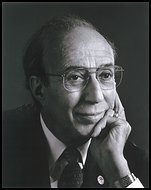Herman Heine Goldstine
Born September 13, 1913, Chicago, Ill.; Army representative to the ENIAC Project, who later worked with John von Neumann on the logical design of the JAS computer which became the prototype for many early computers-ILLIAC, JOHNNIAC, MANIAC author of The Computer from Pascal to von Neumann, one of the earliest textbooks on the history of computing.

Education: BS, mathematics, University of Chicago, 1933; MS, mathematics, University of Chicago, 1934; PhD, mathematics, University of Chicago, 1936.
Professional Experience: University of Chicago: research assistant, 1936-1937, instructor, 1937-1939; assistant professor, University of Michigan, 1939-1941; US Army, Ballistic Research Laboratory, Aberdeen, Md., 1941-1946; Institute for Advanced Study, Princeton University, 1946-1957; IBM: director, Mathematics Sciences Department, 1958-1965, IBM fellow, 1969.
Honors and Awards: IEEE Computer Society Pioneer Award, 1980; National Medal of Science, 1985; member, Information Processing Hall of Fame, Infornart, Dallas, Texas, 1985.
Herman H. Goldstine began his scientific career as a mathematician and had a life-long interest in the interaction of mathematical ideas and technology. He received his PhD in mathematics from the University of Chicago in 1936 and was an assistant professor at the University of Michigan when he entered the Army in 1941. After participating in the development of the first electronic computer (ENIAC), he left the Army in 1945, and from 1946 to 1957 he was a member of the Institute for Advanced Study (IAS), where he collaborated with John von Neumann in a series of scientific papers on subjects related to their work on the Institute computer. In 1958 he joined IBM Corporation as a member of the research planning staff. He was director of mathematical sciences at the Thomas J. Watson Research Center, 1958-1965; director of scientific development of the data processing division, 1965-1967; and consultant to the director of research, 1967-1969. In 1969 he was appointed as an IBM fellow. He wrote his book on the history of computing in 1972, primarily to highlight John von Neumann's contributions. Goldstine claimed that he introduced John von Neumann to the existence of the ENIAC in a chance meeting which took place on the railroad station platform in Philadelphia in the summer of 1944, although as a member of the Scientific Advisory Committee of the Ballistics Research Laboratories, von Neumann probably should have known of the contract with the University of Pennsylvania. Goldstine has been highly supportive of the claims attributed to von Neumann of the invention of the "stored program concept."
At the founding of Hampshire College in Amherst, Mass., Goldstine contributed his archives to the school. This is said to include a handwritten copy of the First Draft of a Report on the EDVAC by von Neumann.
BIBLIOGRAPHY
Biographical
Bigelow, Julian, "Computer Development at the Institute for Advanced Study," in Metropolis, N., J. Howlett, and Gian-Carlo Rota, A History of Computing in the Twentieth Century, Academic Press, New York, 1980, pp. 291-310.
Burks, Arthur W., and Alice R. Burks, "The ENIAC: First General Purpose Electronic Computer," Ann. Hist. Comp., Vol. 3, No. 4,1981, pp. 310-399.
Goldstine, H.H., "Remembrances of Things Past," in Nash, Stephen G., A History of Scientific Computing, ACM Press History Series, ACM, New York, 1990, pp. 5-16.
Significant Publications
Eckert, J. Presper, Jr., John W. Mauchly, Herman H. Goldstine, and J. G. Brainerd, Description of the ENJAC and Comments on Electronic Digital Computing Machinery, Contract W/670/ORD 4926, Moore School of Electrical Engineering, Univ. of Pennsylvania, Philadelphia, Nov. 30, 1945.
Goldstine, Herman H., The Computer from Pascal to von Neumann, Princeton Univ. Press, Princeton, N.J., 1972, 378 pp.
Goldstine, Herman H., and Adele Goldstine, "The Electronic Numerical Integrator and Computer (ENIAC)," Math. Tables and Other Aids to Comp., Vol. 2, No. 15, 1946, pp. 97-110; reprinted in Randell, Brian, Origins of Digital Computers: Selected Papers, Springer-Verlag, Berlin, 1982, pp. 359-374.
UPDATES
Herman Goldstine died June 16, 2004 (MRW, 2012)
New content Copyright © 2013-2023 by the IEEE Computer Society and the Institute of Electrical and Electronics Engineers Inc.
All rights reserved. This material may not be reproduced or redistributed without the express written permission of the copyright holder.
